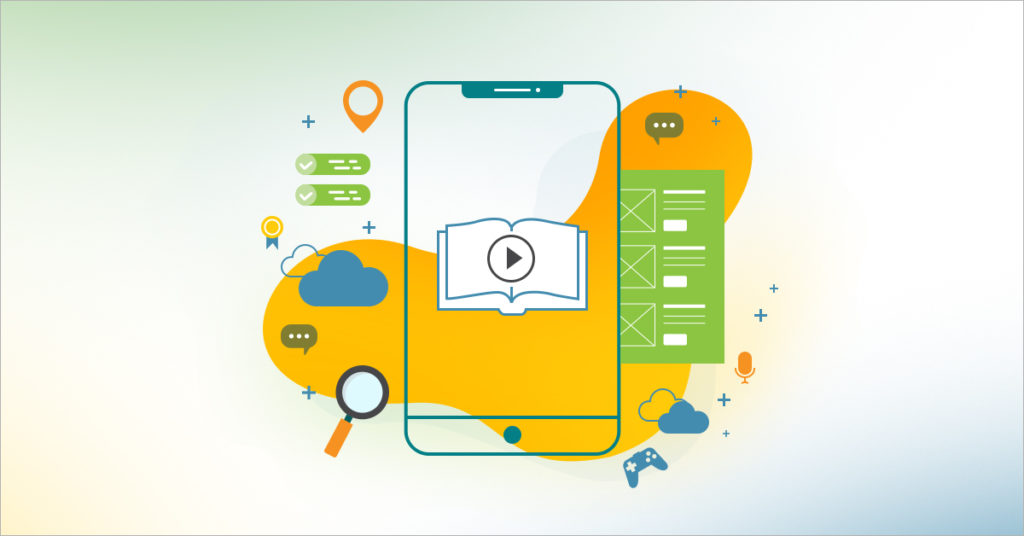Mobile Learning Apps or mLearning apps are reshaping the way traditional workplace learning is being delivered. Going beyond the limits of the workplace, mobile learning is also having a significant positive impact on education in schools and universities. The smartphone has become an integral part of our lives. Research shows that the average American looks at their smartphone 52 times a day.

Mobile learning apps are used for functions as varied as ordering food, booking personal transport, checking weather updates, and carrying out banking transactions. It is no surprise that organizations seek to explore mobile learning as a medium to train their employees. At the workplace, larger organizations are finding it increasingly difficult to conduct training sessions without employees sacrificing their productive work hours.
This is the reason why more organizations are shifting towards microlearning videos that can be easily accessed by employees on their smartphones. Most learning management systems now offer a heavily scaled-down mobile app as well, though it does not offer a complete learning experience. In such a scenario, it makes sense to invest in a dedicated mobile learning app for your employees or opt for a learning experience platform that provides a full-scale app experience. Be it the cost factor or the ease with which mobile learning lessons can be updated, app-based mobile learning is here to stay. In this blog post, we offer a ready reckoner of ideas, tips, and features that your mobile learning app should possess.
Table of Contents
Advantages of a Mobile Learning App
- Create a powerful internal training tool
- Let employees learn at their convenience
- Save on in-person training costs
- No delays to day-to-day projects
- Track learner progress
- Distribute digital badges to employees
- Ideal platform to deploy microlearning videos
Design for Both iOS and Android
Have a look at the November 12th issue of the ‘Forbes’ magazine.

Today we have only two mobile operating systems that make up the bulk of smartphones being sold – Android and iOS. Kai OS is designed for inexpensive and basic mobile phones with WhatsApp and basic communication and entertainment apps.
So, when you design your mobile learning app, don’t play posh, and don’t just stick to the common user. Design both Android and iOS versions of your mobile eLearning app. Also, keep scalability in mind. As every year sees a new iteration or version of the operating system, ensure that your app does not turn redundant, and can be suitably upgraded to be compatible with newer versions of the OS.
Keep your Mobile Learning App Simple
Too often we see organizations cramming several features into a mobile app. Remember with the average smartphone screen, one only has limited real estate on offer. So instead of cramming your mobile learning app with loads of features that will be hardly used, stick to the basics. Minimalism as a design methodology has been embraced by product designers globally. Your app should strike the perfect balance between minimalism, usability, and features. To summarize, keep your target audience in mind, offer a consumer-grade user experience, and keep it simple.
Learner-Focused Design
Continuing from the previous section, ‘learner experience design’ and ‘learner-focused design’ are two terms that have to receive a lot of traction in the world of eLearning. The reason why you are creating a mobile learning app is that you are giving your users an option to switch outside the corporate LMS or intranet and learn at their own convenience. A learner-focused or learner-centric design ensures that your learners have a good learning experience. A simple example would be the use of pop-ups within a mobile eLearning app. It can be quite irritating for a floating pop-up to appear and one struggling to close it before moving on to the learning content. As marketing and advertising guru Rory Sutherland opines in a podcast – ‘Even a small change in the interface can have a significant change in user-behavior.’
Offline Learning
This is one of the key features that your mobile learning app should possess. Support offline learning by allowing learners to download lessons on to their mobile devices, which they can study later without depending on internet connectivity. Ideally, once they are back online, the learning progress/status should auto-sync.
Voice-Enabled Mobile Learning App
In the era of Siri, Alexa, Bixby, and Google Now – voice assistants are becoming a key feature in IoT-connected devices. Surveys by various agencies show that more people are using their voices to search for things on the internet instead of typing out their search queries. In such a scenario, when you create a mobile learning app, it will make sense to incorporate voice-enabled search within the app. How cool would it be for your learners to name a topic and then the app presents the courses relevant to the topic.
Single-Handed Use
I have always marveled at people who type with a single finger on their smartphone with consummate ease. They may be using a bus or train to commute, or standing in a queue, one hand holding on to a bag or a briefcase and the other hand flying over their mobile screen. Design your mobile learning app in such a way that it can be used easily with a single hand. Of course, if the user has a gigantic tablet device masquerading as a smartphone this logic will not work. One also needs to keep in mind that everyone has a different style of typing, based on the thickness of their hands, and dexterity of their fingers. Design the input functions on the touchscreen keypad in such a way that the input errors are substantially reduced.
Gamification & Digital Badges
Gamification of eLearning is a topic that never dies. Now with the growth of mobile learning apps, the scope for creating gamified learning is much better. Studycat is a popular language learning app designed for children to learn new languages. With a cat that plays the role of a guide, children enjoy learning new languages through the simple games and activities built into the learning app.

Digital badges are becoming an important part of the eLearning ecosystem. Ensure that your mobile learning app offers digital badges and a rewards system that rewards learners for completing their lessons. A reward-based learning system motivates learners to complete their training on time.
Mobile-First Design
Design your mobile learning app with a mobile-first design philosophy. Linking back to our earlier paragraphs on learner-focused design and keeping the app design simple and functional. See the example below:

Adobe shared a guide to mobile app design that was published on the Smashing Magazine website. The guide continues to be a popular learning resource.
At Origin, we have built mobile eLearning apps based on specific requirements from our clients. We developed an iOS only app as per the client’s requirements for a global consulting firm. The app was designed specifically for an event that the client was organizing to showcase their plans for the near future and was created as a VR experience. Origin Fractal LXP is a mobile-first, cloud-based, agile learning experience platform designed specifically for extended enterprise learning and customer education. Designed with the learner at the center of the complete learning experience, Origin Fractal LXP is a refreshing new way to learn. Here are various use-case scenarios where an LXP can help you.
Conclusion
As workplace learning and training shifts towards a mobile-first learning experience, eLearning providers are coming up with innovative mobile learning apps to foster continuous learning. Udemy is one of the most popular eLearning websites offering a variety of interesting video-based courses across topics. In this insightful case study by Jelvin Base, readers get a clear understanding of the visual design philosophy and user experience that Udemy offers. As an organization focused on fostering employee learning it is important for you to have a mobile app-based learning strategy. Get in touch with us to build your mobile learning app.
Additional Reading Resources:
https://wisdmlabs.com/blog/9-must-have-features-e-learning-mobile-app/
http://theelearningcoach.com/mobile/mobile-learning-and-support-app-design/
